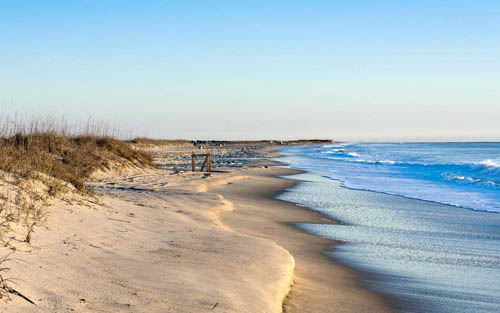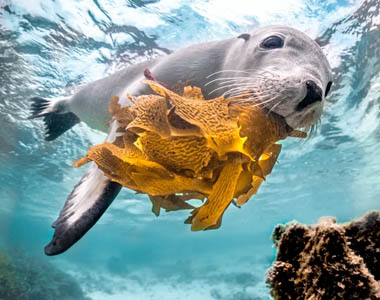 | | |  As summer approaches, many are looking to the ocean for beauty and relaxation. However, with the advent of summer also come heightened risks to oceans and coastal regions. As summer approaches, many are looking to the ocean for beauty and relaxation. However, with the advent of summer also come heightened risks to oceans and coastal regions.
This year, oceans reached the warmest temperatures recorded in recent history, a 1.5°F increase from 1986. Rising ocean temperatures have led to reduced oxygen levels due to the lower capacity for warm water to store dissolved gas, with detrimental effects for marine life.
Coastal towns and cities have also endured climate hazards this month. Rapid snowmelt has led to severe flooding in southwestern Alaska since May 15th, with damage to homes and other buildings. Beachfront houses in North Carolina and California also face risks from shoreline erosion. In light of the challenges facing our oceans and coastal communities, several states have taken initiatives to protect coastal habitat and communities. Louisiana’s House Committee on Natural Resources and Environment has approved a plan to allocate $50 billion to coastal protection and restoration. The plan includes funding for shoreline protection projects, like oyster reef restoration, floodproofing buildings, and sediment dredging. Elsewhere in the southeast, the North Carolina Coastal Federation is developing a Salt Marsh Conservation Action Plan to gather information on potential changes in salt marsh habitat to guide restoration and conservation strategies. Other states have put coastal resilience strategies into action. The American Littoral Society has begun implementing nature-based solutions in New Jersey with the installation of coconut fiber logs along the shoreline. An effective alternative to bulkheads and other hardened infrastructure, the logs serve to mitigate erosion and restore coastal plant habitat. As climate change leads to increased frequency and intensity of coastal storms, North Carolina looks to support hurricane-impacted counties. The state is offering $47 million to assist eligible counties in the construction and renovation of homes to promote climate resilience. Local governments should submit letters of interest by June 27th.  Environmental artists have also devoted their efforts to supporting coasts and oceans. One-hundred photographers have joined forces in the 100 for the Ocean initiative to raise funds for non-profit organizations focused on ocean conservation. In Laguna Beach, California, Sonny Behan painted a mural to remind beachgoers of the effects of plastic pollution on the ocean. Environmental artists have also devoted their efforts to supporting coasts and oceans. One-hundred photographers have joined forces in the 100 for the Ocean initiative to raise funds for non-profit organizations focused on ocean conservation. In Laguna Beach, California, Sonny Behan painted a mural to remind beachgoers of the effects of plastic pollution on the ocean.
These initiatives to restore coastal habitat, empower local communities, and support ocean conservation through art provide a beacon of hope ahead of Capitol Hill Oceans Week (CHOW), a program which will focus on the role of ocean conservation in climate change mitigation strategies. The events begin on June 6th and end on June 8th, World Oceans Day. As you hit the beach this summer, we encourage you to reflect on your role in maintaining the beauty of our oceans and to engage in coastal conservation. | | | | | | | |  Emma Brentjens is the co-lead of the RCC Coasts and Oceans program. She is a Master of Environmental Management student at Duke University studying Ecosystem Science and Conservation and Community-based Environmental Management. Emma Brentjens is the co-lead of the RCC Coasts and Oceans program. She is a Master of Environmental Management student at Duke University studying Ecosystem Science and Conservation and Community-based Environmental Management. | | | | | | As Ocean Oxygen Levels Dip, Fish Face an Uncertain Future Global warming not only increases ocean temperatures, it triggers a cascade of effects that are stripping the seas of oxygen. Fish are already moving to new waters in search of oxygen, and scientists are warning of the long-term threat to fish species and marine ecosystems. Off the coast of southeastern China, one particular fish species is booming: the oddly named Bombay duck, a long, slim fish with a distinctive, gaping jaw and a texture like jelly. | | | | | | | | How Coconuts Are Being Used to Save New Jersey Beaches From Erosion Logs made of coconut fibers are helping protect and restore coastal habitats along the New Jersey shoreline. Spearheading the project is the conservation group American Littoral Society, which said the coconut fibers help create "living shorelines" that provide an alternative approach to seawalls, bulkheads and other structures traditionally used to stabilize land. The logs begin their lives in India and Indonesia, where coconut fibers are sourced and then transported to the Lower 48. | | | | | | | | North Carolina Beach Houses Have Fallen Into the Ocean. Is There a Fix? New studies show that both beach nourishments and buyouts in Rodanthe, N.C., would be costly. But no funding for any fix is in sight. It’s been a rough stretch for Rodanthe, N.C., a scenic sliver of the Outer Banks where houses are crumbling into the ocean, owners are paying to move properties farther from the pounding surf and residents are pushing officials to do more to protect the fast-eroding shoreline. | | | | | | | | $50 Billion Plan to Restore, Protect Louisiana Coast Advances Through House Committee Louisiana’s most recent plan to restore and protect its coast at a cost of $50 billion advanced Wednesday through the House Committee on Natural Resources and Environment. The coastal master plan is updated by the Coastal Protection and Restoration Authority every six years, as required by state law. It lays out the 50-year future for Louisiana’s coast in terms of coastal land loss and flood risk–with and without its implementation. | | | | | | | | N.C. Coastal Federation Takes State Lead in Salt Marsh Conservation Effort The N.C. Carolina Coastal Federation is leading an initiative for the North Carolina Salt Marsh Conservation Action Plan. This plan will provide a detailed geospatial analysis of the current and future projections of salt marsh gain or loss, a reference guide of potential priority strategies for marsh restoration and migration facilitation, and a local stakeholder-informed plan to begin implementation of specific actions. “No wetlands means no seafood,” said Todd Miller, executive director and founder of the federation. | | | | | | | | A Record Warm Streak in the Oceans Has Scientists Worried A budding El Niño and climate change likely play a role, experts say. The world’s oceans have reached their warmest levels in modern history, outpacing climate forecasts and alarming scientists. Daily ocean temperatures have been trending warmer than normal every day for the past month and a half, approximately. Experts warn the pattern does not bode well for marine life and human well-being. | | | | | | | | Officials, Advocates Answer Questions on Solar, Wind Power “What happens to solar panels during a hurricane?” This was one of the first questions asked during a renewable energy symposium in Carteret Community College’s Joslyn Hall the week of Earth Day. “Being a company based here on the coast, we are well aware that there are environmental challenges,” including salty air, strong winds and storms. | | | | | | | | Flooding Study Reveals Factors NOAA Forecasts Don’t Include Beaufort’s historic Front Street is a bustling hub for local businesses, and strolling around the area is a must-do for tourists. But all this activity is disrupted when the town experiences flooding. According to the National Oceanic and Atmospheric Administration, this has been happening more frequently over the past 20 years and will become increasingly common as sea levels continue to rise. | | | | | | | | Record Flooding Destroys Homes and Prompts Evacuations in Southwest and Interior Alaska Historic ice jam flooding along the Yukon and Kuskokwim rivers destroyed homes and caused major damage in two Alaska communities. By Monday, residents in Circle, on the Yukon, and Crooked Creek, on the Kuskokwim, began to grapple with damage that included multiple homes lifted from their foundations, slammed by ice or inundated after floodwaters rose quickly Saturday and receded into Sunday. | | | | | | | | As California Attempts a ‘managed retreat,’ Coastal Homeowners Sue to Stay A legal battle in Half Moon Bay could derail the state's climate adaptation push. Mirada Road is a small cul-de-sac that runs right up to the edge of the Pacific Ocean, skirting the rim of a 30-foot bluff. The townhomes on this street, which is located in Half Moon Bay, California, are separated from the sea by nothing but a pedestrian walking trail on a beach that is eroding a few inches every year. | | | | | | | | State Has $47M For Hurricane-impacted Residents Local governments in impacted and distressed counties are encouraged to apply for the $47 million the North Carolina Office of Recovery and Resiliency expects to award by this fall for housing that increases community resilience. This is the third phase of the Affordable Housing Development Fund program, and the money is for financing multifamily or single-family housing rehabilitation and new construction outside the 100-year floodplain, officials said this week. | | | | | | | | Massachusetts Turtles Released on NC Beach: A Photo Essay Ten loggerhead sea turtles touched down at Michael J. Smith Field in Beaufort Monday, May 1, ahead of their release back into the Atlantic Ocean. The loggerheads were rehabilitating at the Johnny Morris’ Wonders of Wildlife National Museum and Aquarium in Springfield, Missouri, after being cold-stunned in early January near Cape Cod. The New England Aquarium in Boston transported the turtles to the nonprofit aquarium in Missouri. | | | | | | | | Light Pollution is Messing With Coral Reproduction A dark side effect of the electricity that helps society run around the clock is the pollution caused by our increasing numbers of lights at night. Light pollution can obscure stargazing, confusing sea turtles when they hatch, and also could be harming coral reefs. The light pollution from cities along the coast can trick the reefs into spawning outside of their optimal reproductive times, according to a study published May 15 in the journal Nature Communications. | | | | | | | | Sonny Behan’s ‘Beneath the Waves’ Advocates For Ocean Conservation in Downtown Laguna A community rich in environmental interests has a new messenger pushing the cause of ocean conservation, as a storytelling, large-scale mural addressing marine plastic pollution has been placed in the heart of downtown Laguna Beach. Sonny Behan, a 36-year-old artist from South Africa, created the piece called “Beneath the Waves,” depicting the Pacific Sea Nettle jellyfish in clear waters on the left and, as viewers works their way across the wall, increasingly in turmoil as it is confronted by unnatural invaders. | | | | | | | | | | Photography for the Ocean – in Pictures Founded by Paul Nicklen, Cristina Mittermeier and Chase Teron, 100 for the Ocean unites 100 world-class photographers selected for their talents and contributions to conservation. Until 31 May 2023, photographs are on sale with profits going to under-funded and under-recognised ocean-focused NGOs voted for by photographers. The top-voted NGOs so far include: Whale Guardians, Coast First Nations, and Por el Mar. “The UN is telling us that in order to fulfil the promise of protecting the ocean under Sustainable Development Goal 14, Life Underwater, we need about $170 billion...” Cristina Mittermeier. | | | | | | | | The Potomac Could Soon Be Safe For Swimming, But it Remains Vulnerable to Pollution Urban sections of the Potomac River are on the brink of becoming safe for swimming, but deforestation and polluted urban runoff are holding back efforts to clean up the waterway, according to a new analysis by environmental advocates. The Potomac Conservancy gave the river a B on its latest report card, matching a high mark last awarded in 2018 and improving upon a B-minus given in 2020. | | | | | | | | The True Cost of Tuna: Marine Observers Dying at Sea The harassment, abuse, and sometimes death of the marine observers who uphold sustainable seafood standards are the industry’s worst-kept secrets. Critics say the people and companies that earn the most money on tuna aren’t doing enough to secure their well-being. Simi Cagilaba could hear the fighting outside his cabin door. In the hallway of the 209-foot tuna seiner, drunken crewmen were roiling the ship yet again. | | | | | | | | Announcing Capitol Hill Ocean Week 2023: The Climate-Ocean Connection Capitol Hill Ocean Week 2023: "Ocean x Climate" will underscore the relationship between climate change and the world's ocean, addressing the importance of understanding how climate change is negatively impacting the health of ocean ecosystems and the coastal communities that rely on them. Capitol Hill Ocean Week is an annual conference attended by scientists, policymakers, scholars, businesses, and members of the public to address pressing science, conservation, and management issues. | | | | | | | | The Bathysphere Book: Effects of the Luminous Ocean Depths  "Hypnotic . . . Beautifully written and beautifully made." --W. M. Akers, The New York Times Book Review "Hypnotic . . . Beautifully written and beautifully made." --W. M. Akers, The New York Times Book Review
"Mesmerizing . . . Original and often profound, [The Bathysphere Book] is a moving testament to the wonders of exploration."--Publishers Weekly, Starred Review
"Imbued with the adventurous spirit of science and exploration . . . [The Bathysphere Book is] an enchanting cabinet of curiosities." --Kirkus Reviews
A wide ranging, philosophical, and sensual account of early deep sea exploration and its afterlives, The Bathysphere Book begins with the first ever voyage to the deep ocean in 1930 and expands to explore the adventures and entanglements of its all-too-human participants at a time when the world still felt entirely new.
In the summer of 1930, aboard a ship floating near the Atlantic island of Nonsuch, marine biologist Gloria Hollister sat on a crate, writing furiously in a notebook with a telephone receiver pressed to her ear. The phone line was attached to a steel cable that plunged 3,000 feet into the sea. There, suspended by the cable, dangled a four-and-a-half-foot steel ball called the bathysphere. Crumpled inside, gazing through three-inch quartz windows at the undersea world, was Hollister's colleague William Beebe. He called up to her, describing previously unseen creatures, explosions of bioluminescence, and strange effects of light and color. Click here to read more and purchase | | | | | |  The Rachel Carson Council Depends on Tax-deductible Gifts From Concerned Individuals Like You. Please Help If You Can. The Rachel Carson Council Depends on Tax-deductible Gifts From Concerned Individuals Like You. Please Help If You Can. | | | | | | | |  Sign Up Here to Receive the RCC E-News and Other RCC Newsletters, Information and Alerts. Sign Up Here to Receive the RCC E-News and Other RCC Newsletters, Information and Alerts. | | | | | | | | | | | |